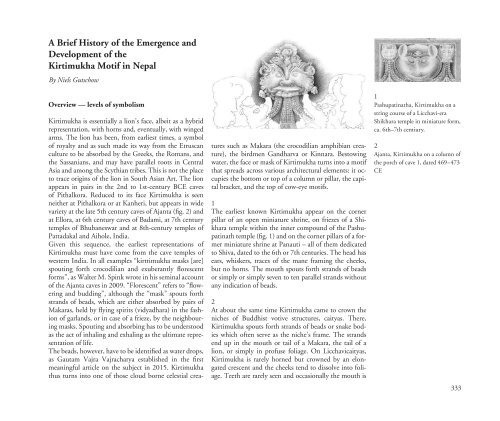KVPT’s Patan Darbar Earthquake Response Campaign - Work to Date - September 2016
You also want an ePaper? Increase the reach of your titles
YUMPU automatically turns print PDFs into web optimized ePapers that Google loves.
A Brief His<strong>to</strong>ry of the Emergence and<br />
Development of the<br />
Kirtimukha Motif in Nepal<br />
By Niels Gutschow<br />
Overview — levels of symbolism<br />
Kirtimukha is essentially a lion’s face, albeit as a hybrid<br />
representation, with horns and, eventually, with winged<br />
arms. The lion has been, from earliest times, a symbol<br />
of royalty and as such made its way from the Etruscan<br />
culture <strong>to</strong> be absorbed by the Greeks, the Romans, and<br />
the Sassanians, and may have parallel roots in Central<br />
Asia and among the Scythian tribes. This is not the place<br />
<strong>to</strong> trace origins of the lion in South Asian Art. The lion<br />
appears in pairs in the 2nd <strong>to</strong> 1st-century BCE caves<br />
of Pithalkora. Reduced <strong>to</strong> its face Kirtimukha is seen<br />
neither at Pithalkora or at Kanheri, but appears in wide<br />
variety at the late 5th century caves of Ajanta (fig. 2) and<br />
at Ellora, at 6th century caves of Badami, at 7th century<br />
temples of Bhubaneswar and at 8th-century temples of<br />
Pattadakal and Aihole, India.<br />
Given this sequence, the earliest representations of<br />
Kirtimukha must have come from the cave temples of<br />
western India. In all examples “kirttimukha masks [are]<br />
spouting forth crocodilian and exuberantly florescent<br />
forms”, as Walter M. Spink wrote in his seminal account<br />
of the Ajanta caves in 2009. “Florescent” refers <strong>to</strong> “flowering<br />
and budding”, although the “mask” spouts forth<br />
strands of beads, which are either absorbed by pairs of<br />
Makaras, held by flying spirits (vidyadhara) in the fashion<br />
of garlands, or in case of a frieze, by the neighbouring<br />
masks. Spouting and absorbing has <strong>to</strong> be unders<strong>to</strong>od<br />
as the act of inhaling and exhaling as the ultimate representation<br />
of life.<br />
The beads, however, have <strong>to</strong> be identified as water drops,<br />
as Gautam Vajra Vajracharya established in the first<br />
meaningful article on the subject in 2015. Kirtimukha<br />
thus turns in<strong>to</strong> one of those cloud borne celestial creatures<br />
such as Makara (the crocodilian amphibian creature),<br />
the birdmen Gandharva or Kinnara. Bes<strong>to</strong>wing<br />
water, the face or mask of Kirtimukha turns in<strong>to</strong> a motif<br />
that spreads across various architectural elements: it occupies<br />
the bot<strong>to</strong>m or <strong>to</strong>p of a column or pillar, the capital<br />
bracket, and the <strong>to</strong>p of cow-eye motifs.<br />
1<br />
The earliest known Kirtimukha appear on the corner<br />
pillar of an open miniature shrine, on friezes of a Shikhara<br />
temple within the inner compound of the Pashupatinath<br />
temple (fig. 1) and on the corner pillars of a former<br />
miniature shrine at Panauti – all of them dedicated<br />
<strong>to</strong> Shiva, dated <strong>to</strong> the 6th or 7th centuries. The head has<br />
ears, whiskers, traces of the mane framing the cheeks,<br />
but no horns. The mouth spouts forth strands of beads<br />
or simply or simply seven <strong>to</strong> ten parallel strands without<br />
any indication of beads.<br />
2<br />
At about the same time Kirtimukha came <strong>to</strong> crown the<br />
niches of Buddhist votive structures, caityas. There,<br />
Kirtimukha spouts forth strands of beads or snake bodies<br />
which often serve as the niche’s frame. The strands<br />
end up in the mouth or tail of a Makara, the tail of a<br />
lion, or simply in profuse foliage. On Licchavicaityas,<br />
Kirtimukha is rarely horned but crowned by an elongated<br />
crescent and the cheeks tend <strong>to</strong> dissolve in<strong>to</strong> foliage.<br />
Teeth are rarely seen and occasionally the mouth is<br />
1<br />
Pashupatinatha, Kirtimukha on a<br />
string course of a Licchavi-era<br />
Shikhara temple in miniature form,<br />
ca. 6th–7th centiury.<br />
2<br />
Ajanta, Kirtimukha on a column of<br />
the porch of cave 1, dated 469–473<br />
CE<br />
333




